Tarantula reproduction.
| General information |
Breeding behaviour | Copulation | Fertilization |
| Incubation | Development | Longevity and maturation | Enemies and "roommates" |
Reproduction of tarantula is a very complicated and follow to note is not enough studied for present moment. Young tarantulas of both sexes lead cognate lifestyle and practically do not differ in its behaviour.
Mature males are differ from females in lifestyle and their appearance. Males of many species are bright in color. They, as a rule, smaller in size, has pro rata more extended legs and other pedipalps morphology and also more active than females.
As a rule, the maturation in males approaches earlier than in females. The average period of male`s maturity approaches about 1.5 years, in females - not earlier than 2 (in some species this difference more disperses in time - 1.5 and 3 years, accordingly), so practically it is introduces that «related» breeding of tarantulas hatched from one eggsac in nature impossible. However this is possible in captivity under creation of different feeding and temperature modes for male and female.
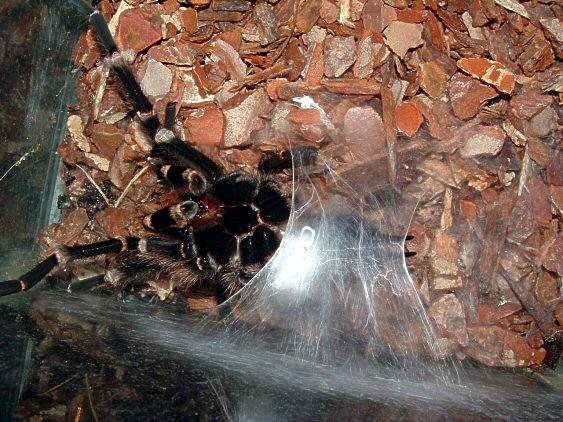 Mature male spins so-called sperm-web before copulation, having, as a rule, specified form (see picture), on lower side of which he attach the drop of semen. The sperm is seized with the copulation apparatus whereupon male starts to searching for female. An this period his behaviour is straight opposite than of preceding life. He leads rambling lifestyle, highly active and can be noted moving even at day time, overcoming in searching for female rather significant distances (7-9 km per night (Shillington et al. 1997).
Mature male spins so-called sperm-web before copulation, having, as a rule, specified form (see picture), on lower side of which he attach the drop of semen. The sperm is seized with the copulation apparatus whereupon male starts to searching for female. An this period his behaviour is straight opposite than of preceding life. He leads rambling lifestyle, highly active and can be noted moving even at day time, overcoming in searching for female rather significant distances (7-9 km per night (Shillington et al. 1997).
Finding the female occurs thanks to senses of touch mainly (a vision does not play a role in this process: tarantula with puttied eyes finds female without any problems) on smelling trace lefted by her on substratum or web near the burrow entrance (for example, female of Aphonopelma hentzi entwines a silken ball).
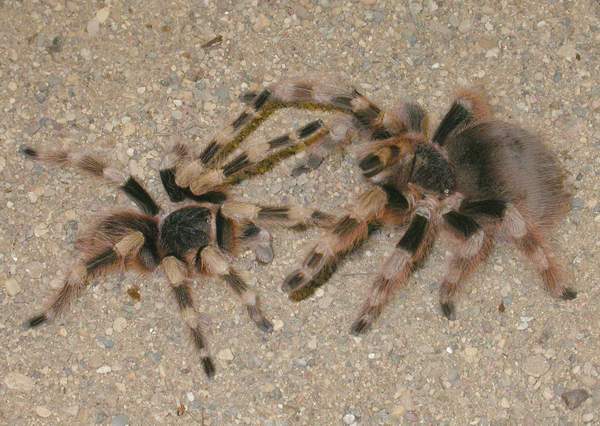 Finding female, male carefully entering inside female`s burrows. When meeting with female two variants of scenario are possible.
Finding female, male carefully entering inside female`s burrows. When meeting with female two variants of scenario are possible.
Under first variant, if female is not ready to mating, she will pay no attention to male or rapidly attack him, having drawn apart chelicerae and preparing to grasp him. In this case male have to hastily run back or, otherwise he can be perceived not as potential partner but became a "filling supper" or lose one or several limbs.
Under second variant female, as a rule, does not show to male no interest firstly. In this case male lowers his front part and raises abdomen, having extended onward placed forelegs and pedipalps, moving backward toward output from burrow, hereunder, attracting attention of female and as it were inviting her follow itself. From time to time he stops and moves forelegs and pedipalps that to the right, that to the left, shudderring with all body, that interest of female to him does not weaken, while they are not reach the burrow entering. Here, having a space for safe movements, it feels itself more certain.
Unlike other species of spiders, for which is characteristic a complex "marriage behaviour", concluding in performance of peculiar "wedding dances", for instance, species of families Araneidae, Salticidae, Lycosidae, or in offer to female the recently killed prey (beside Pisauridae), courtship of tarantulas comparatively more simple.
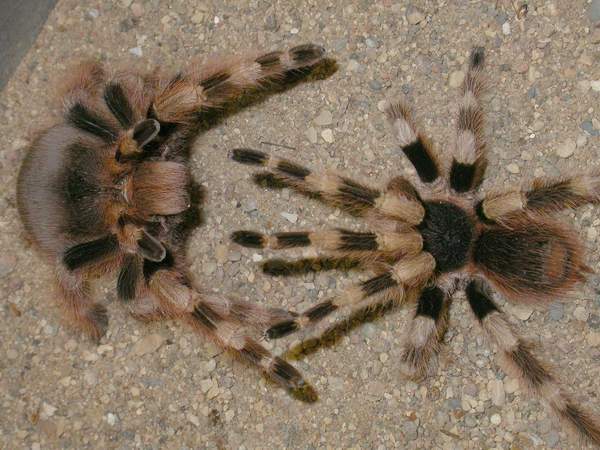 Male periodically carefully approaches to female, quickly touch her with its tips of front legs and pedipalps or/and «drums» on substratum. Usually it repeats this procedure with small breaks several times, until it will make sure in that behaviour of female does not present dangers for him and does not cause him any harm (before present moment there were no wide studies for finding of particularities typical of "marriage behaviour" of different species is organized).
Male periodically carefully approaches to female, quickly touch her with its tips of front legs and pedipalps or/and «drums» on substratum. Usually it repeats this procedure with small breaks several times, until it will make sure in that behaviour of female does not present dangers for him and does not cause him any harm (before present moment there were no wide studies for finding of particularities typical of "marriage behaviour" of different species is organized).
If female so far passive, male will slowly approaches to her, undersea his front legs between her pedipalps and chelicerae, which female usually moves apart in the event of readiness to mating. Then he as abuts against it with his tibial hooks (spurs), to occupy a steady position and lift her prosoma stroking up from time to time the lower surface of her abdomen`s basis.
If female expresses readiness to mating (that also is display in frequent «drummimg» sound, producing by knocks with legs on substratum) he unwinds the pedipalps embolus and iserts it in female`s gonopore, which inheres at epigastric furrow. Such action a male produces with both of his pedipalp. This is strictly a moment of copulation, which lasts literally several seconds, after that male rapidly runs away because female usually immediately begins to pursue him.
Notwithstanding existing opinion that female often eats her partners after mating, in most cases does not occur (moreover, knowned events of eating the females by males) if there is enough place for him, to move away on significant distance, and the male able in a certain time to mate with several females. Often also female for one season mates with different males.
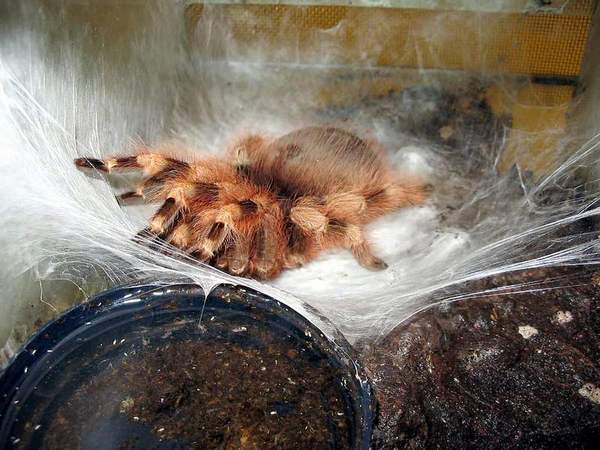 Fertization of eggs occurs in womb and within determined period after copulation occured (from 1 to 8 months), duration of which inheres in direct dependency from different conditions (seasonal, temperature, humidity/moisture, presence of food, period from female`s last molt etc.) and concrete species of tarantula, female lays eggs, entwined them in eggsac (cocoon). Whole this process occurs in dwelling camera of burrow, which changes in "nest". Eggsac, as a rule, consists in two parts, attached by its edges. First spins the basic part, then eggs laying upon it and finally it is plaited with roofing part. Some species (Avicularia spp., Theraphosa blondi) plate into cocoon walls their «urticating hairs» for its protections from possible enemies.
Fertization of eggs occurs in womb and within determined period after copulation occured (from 1 to 8 months), duration of which inheres in direct dependency from different conditions (seasonal, temperature, humidity/moisture, presence of food, period from female`s last molt etc.) and concrete species of tarantula, female lays eggs, entwined them in eggsac (cocoon). Whole this process occurs in dwelling camera of burrow, which changes in "nest". Eggsac, as a rule, consists in two parts, attached by its edges. First spins the basic part, then eggs laying upon it and finally it is plaited with roofing part. Some species (Avicularia spp., Theraphosa blondi) plate into cocoon walls their «urticating hairs» for its protections from possible enemies.
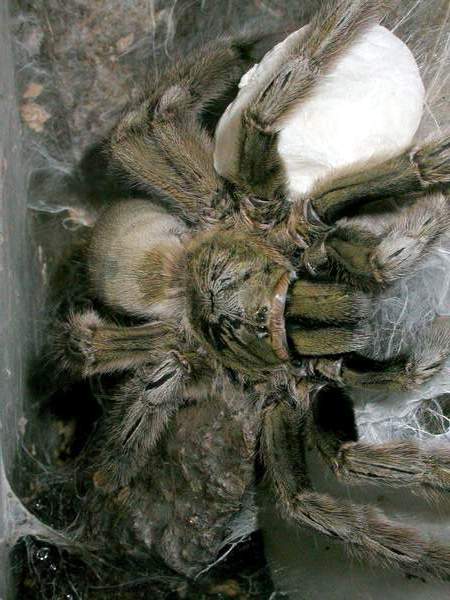 Unlike majority of other spiders, female of tarantula protects eggsac and takes care of it, being turning it over periodically by chelicerae and pedipalps and also moving it depending on change of the conditions of humidity and temperature. There are determined difficulties with artificial incubation of eggs in home conditions are bound with it. But in many cases it is reasonable to artificially incubate eggsacs since cases of eating its by females are not rare in hobby as a result of "stress" caused by enxiety so as «on unknown reasons». To this effect amateurs from USA, Germany, England, Australia have developped an incubator, but some amateurs, withdrewing cocoons from females, take their "maternal" functions on itself, turning over cocoon manually several times a day (see also Breeding).
Unlike majority of other spiders, female of tarantula protects eggsac and takes care of it, being turning it over periodically by chelicerae and pedipalps and also moving it depending on change of the conditions of humidity and temperature. There are determined difficulties with artificial incubation of eggs in home conditions are bound with it. But in many cases it is reasonable to artificially incubate eggsacs since cases of eating its by females are not rare in hobby as a result of "stress" caused by enxiety so as «on unknown reasons». To this effect amateurs from USA, Germany, England, Australia have developped an incubator, but some amateurs, withdrewing cocoons from females, take their "maternal" functions on itself, turning over cocoon manually several times a day (see also Breeding).
Interesting that for several species of tarantulas several facts of "double clutching" are reported (several eggsacs laying by female one after other within month or so): Hysterocrates spp., Stromatopelma spp., Holothele spp., Psalmopoeus spp., Tapinauchenius spp., Metriopelma spp., Pterinochilus spp. (Rick West, 2002), Ephebopus murinus и E. cyanognathus (Alex Hooijer, 2002), Poecilotheria regalis (Yan Evenow, 2002) and Haplopelma lividum. Herewith percent correlation of fertilized eggs vastly increases in repeated layings.
Amount of layed eggs is distinguished beside different species and is connected with female`s size, age, other factors. Record amount off eggs known for species Lasiodora parahybana and forms aproximately 2500! Opposite, beside small species does not exceed 30-60. Periods of incubation also different – from 0,8 till 4 months. Interesting that for arboreal tarantulas typical more short periods, than for terrestrals (see Table).
|
№ |
Species |
Period* of incubation |
Information source |
|
1. |
Acanthoscurria musculosa |
83 |
Eugeniy Rogov, 2003 |
|
2. |
Aphonopelma anax |
68 |
John Hoke, 2001 |
|
3. |
Aphonopelma caniceps |
64 |
McKee,1986 |
|
4. |
Aphonopelma chalcodes |
94 |
Schultz & Schultz |
|
5. |
Aphonopelma hentzi |
76 |
McKee,1986 |
|
56 |
Baerg, 1958 |
||
|
6. |
Aphonopelma seemanni |
86 |
McKee,1986 |
|
7. |
Avicularia avicularia |
52 |
McKee,1986 |
|
39, 40,45 |
Garrick Odell, 2003 |
||
|
51 |
Stradling, 1994 |
||
|
8. |
Avicularia metallica |
68 |
Todd Gearhart, 1996 |
|
9. |
Avicularia sp. (ex. Peru) |
37 |
Emil Morozov, 1999 |
|
59 |
Denis A. Ivashov, 2005 |
||
|
10. |
Avicularia versicolor |
29 |
Thomas Schumm, 2001 |
|
46 |
Mikhail F. Bagaturov, 2004 |
||
|
35 |
Todd Gearhart, 2001 |
||
|
11. |
Brachypelma albopilosum |
72 |
McKee,1986 |
|
75, 77 |
|
||
|
12. |
Brachypelma auratum |
76 |
McKee,1986 |
|
13. |
Brachypelma emilia |
92 |
Schultz & Schultz |
|
14. |
Brachypelma smithi |
91 |
McKee,1986 |
|
66 |
Todd Gearhart, 2001 |
||
|
15. |
Brachypelma vagans |
69 |
McKee,1986 |
|
71 |
Todd Gearhart, 2002 |
||
|
16. |
Ceratogyrus behuanicus |
20 |
Phil&Tracy, 2001 |
|
17. |
Ceratogyrus darlingi |
38 |
Thomas Ezendam, 1996 |
|
18. |
Cyclosternum fasciatum |
52 |
McKee,1986 |
|
19. |
Chilobrachys fimbriatus |
73 |
V. Sejna, 2004 |
|
20. |
Encyocratella olivacea |
28 |
V. Kumar, 2004 |
|
21. |
Eucratoscelus constrictus |
25 |
Rick C. West, 2000 |
|
22 |
Eucratoscelus pachypus |
101 |
Richard C. Gallon, 2003 |
|
23. |
Eupalaestrus campestratus |
49 |
Todd Gearhart, 1999 |
|
24. |
Eupalaestrus weijenberghi |
76 |
Costa&Perez-Miles, 2002 |
|
25. |
Grammostola aureostriata |
29 |
Todd Gearhart, 2000 |
|
26. |
Grammostola burzaquensis |
50-55 |
Ibarra-Grasso,1961 |
|
27. |
Grammostola iheringi |
67 |
McKee,1986 |
|
28. |
Grammostola rosea |
54 |
McKee,1986 |
|
29. |
Haplopelma lividum |
56 |
Rhys A. Bridgida, 2000 |
|
60 |
John Hoke, 2001 |
||
|
52 |
Mikhail Bagaturov, 2002 |
||
|
30. |
Haplopelma minax |
30 |
John Hoke, 2001 |
|
31. |
Haplopelma sp. "longipedum" |
73 |
Todd Gearhart, 2002 |
|
32 |
Heterothele villosella |
67 |
Amanda Weigand, 2004 |
|
33 |
Heteroscodra maculata |
39 |
Graeme Wright, 2005 |
|
34 |
Holothele incei |
36, 22 |
Benoit, 2005 |
|
34 |
Dmitry Belkin, 2006 |
||
|
35. |
Hysterocrates scepticus |
40 |
Todd Gearhart, 1998 |
|
36. |
Hysterocrates gigas |
37, 52 |
Mike Jope, 2000 |
|
89 |
Chris Sainsburry, 2002 |
||
|
37. |
Lasiodora cristata |
62 |
Dirk Eckardt, 2000 |
|
38. |
Lasiodora difficilis |
68 |
Todd Gearhart, 2002 |
|
39. |
Lasiodora parahybana |
106 |
Dirk Eckardt, 2000 |
|
85 |
Eugeniy Rogov, 2002 |
||
|
40. |
Megaphobema robustum |
51 |
Dirk Eckardt, 2001 |
|
41. |
Nhandu coloratovillosus |
59 |
Mikhail Bagaturov, 2004 |
|
42. |
Oligoxystre argentinense |
37-41 |
Costa&Perez-Miles, 2002 |
|
43. |
Pachistopelma rufonigrum |
36,40 |
S.Dias&A.Brescovit, 2003 |
|
44 |
Pamphobeteus sp. platyomma |
122 |
Thomas (Germany), 2005 |
|
45. |
Phlogiellus inermis |
40 |
John Hoke, 2001 |
|
46. |
Phlogius crassipes |
38 |
Steve Nunn, 2001 |
|
47. |
Phlogius stirlingi |
44 |
Steve Nunn, 2001 |
|
48 |
Phormictopus cancerides |
40 |
Gabe Motuz, 2005 |
|
49 |
Phormictopus sp. "platus" |
61 |
V. Vakhrushev, 2005 |
|
50. |
Plesiopelma longisternale |
49 |
F.Costa&F.Perez-Miles, 1992 |
|
Poecilotheria fasciata |
97 |
Dmitry Belkin, 2006 |
|
|
51. |
Poecilotheria ornata |
66 |
Todd Gearhart, 2001 |
|
52. |
Poecilotheria regalis |
43 |
Todd Gearhart, 2002 |
|
77 |
Chris Sainsburry, 2005 |
||
|
53. |
Psalmopoeus cambridgei |
46 |
Alexey Sergeev, 2001 |
|
54. |
Psalmopoeus irminia |
76 |
Guy Tansley, 2005 |
|
55. |
Pterinochilus chordatus |
23, 38 |
Mike Jope, 2000 |
|
56. |
Pterinochilus murinus |
26, 37 |
Mike Jope, 2000 |
|
22, 23, 25 |
Phil Messanger, 2000 |
||
|
57. |
Stromatopelma calceatum |
47 |
Eugeniy Rogov, 2002 |
|
58. |
Stromatopelma c. griseipes |
53 |
Celerier, 1981 |
|
59 |
Thrigmopoeus truculentus |
79, 85, 74 |
J.-M.Verdez&F.Cleton, 2002 |
|
60. |
Tapinauchenius plumipes |
48 |
John Hoke, 2001 |
|
61. |
Theraphosa blondi |
66 |
Todd Gearhart, 1999 |
|
62. |
Vitalius roseus |
56 |
Dirk Eckardt, 2000 |
|
*Average temperature of incubation – 27°С, relative humidity - 80 %, except eggsacs of P. cambridgei, C. darlingi and M. robustum, were incubated under 25°С |
Size of newborn spiderlings fluctuates in a wide limit from 3-5 mm (for example, Cyclosternum spp.) up to 1,5 sm in legspan at goliaph tarantula Theraphosa blondi. Newborn arboreal tarantulas, as a rule, are larger than those, born at terrestrial species and their amount usually noticeably less (as a rule, does not exceed 250 pieces).
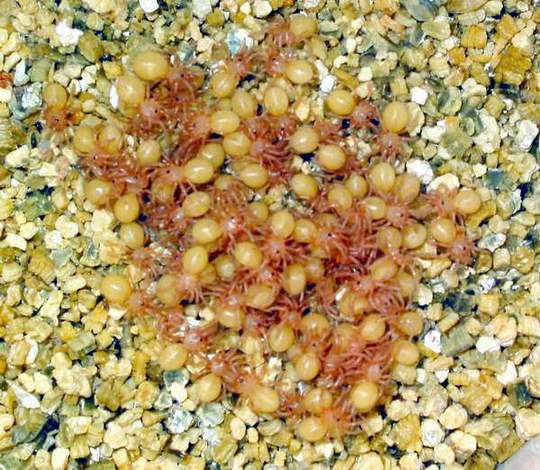 Spiderlings is very mobile and at the slightest danger hides, escapes in the nearest shelter or promptly dug in the ground. Such behaviour is marked both for arboreal and terrestrial tarantulas.
Spiderlings is very mobile and at the slightest danger hides, escapes in the nearest shelter or promptly dug in the ground. Such behaviour is marked both for arboreal and terrestrial tarantulas.
Hatchling from eggs of one laying occurs more or less in identical terms. Before hatchling in the bases of pedipalps of a germ are formed small thorn «egg teeths», with the help of which it breaks shell of egg and appears "on light".
Before so-called postembrional molt occurring in nature, as a rule, inwardly cocoon, hatched spider has very fine covers, his apurtenance is not dismembered, it can`t eat and lives at the expense of yolk bag, remaining in intestines. This life stage carries name «prelarvae» (on other categorizations – 1st stage nymph). After following molting (3-5 weeks) prelarvae moves over to «larvae» stage (or 2d stage nymph ), also not yet eating (this is discussable), but more mobile and already having primitiv claws on toes and developed chelicerae (Vachon, 1957).
With next (postembrional) molt they are formed in young tarantulas (spiderling) which, becoming more active and capable to eat, emerged from eggsac and for the first time, as a rule, stand together, but afterwards scatter in different sides, starts an independent lifes.
Usually after leaving spiderlings a mother anymore takes care of them, but interesting particularity of biology of species Hysterocrates sp. from Sao-Tome island noted where are spiderlings found to inhabits in one burrows with their mom. Female shows the real care about them, not shown more beside one of any other representative of Theraphosidae family (but some reports are known of another species). She actively protecting them from any possible danger and gaining them a feed.
The biology and lifestyle of young tarantulas, as a rule, the same as such of adult spiders. They dig or construct itself a retreats, actively hunt on suitable in size food objects. Amount of molting during life is distinguished and depending on size of spider and to its sexual belonging (beside males their amount always less), 9 - 15 during the life.
In general the lifespan of female tarantula also varied.
Arboreals, even such large spiders, as Poecilotheria spp. as well as of terrestrials of genus Pterinochilus live not more than 7 - 14 years. Large terrestrials and particularly tarantulas of America lives in captivity till 20 years, but on available separate messages and before more venerable age (so, age of female Brachypelma emilia which lived on S. Schultz and M. Schultz was numberred, at least, in 35 years).
Lifespan of males greatly less and, in general, limited with 3-3,5 years. This is because males, as was it already mentionned above, matures earlier then females (1,5-2,5 years) and, as a rule, intermediate lifespan of mature males (after postultimate molt) forms five - six months. However, for separate specimens of some species are known vastly greater data.
So, on message of Dr. Claudio Lipari, time-limits of lifespan of mature males of brazilian black Grammostola pulchra have formed not less then 27 months, and one specimen has lived more then 4 years.
Other long-lived specimens amongst mature males by Lucian Ross, are:
Grammostola rosea - 18 months, Megaphobema velvetosoma - 9 months, Poecilotheria formosa - 11 months, Poecilotheria ornata - 13 months, Poecilotheria rufilata - 17 months.
On information of Moscow collector Igor Arhangelsky mature male of Brachypelma vagans has lived about 24 months and the other one of the same species - 20 months.
According to information of canadian scientist Rick West mature male of Phormictopus cancerides has lived at Allan McKee (lost after molting upper segments of pedipalps) - 27 months and a male of Brachypelma albopilosa at rick West - 30 months and dies after a second postultimate molt.
Also noted the following facts: Lasiodora parahybana: 3 years at Jeff Lee, 2 years 6 months at Joy Reed and 2 years 3 months at Jim Hitchiner.
The male of tarantula Grammostola rosea has lived 2 years and 5 months at Jey Staples.
It is known unique case when at Jay Stotzky small sized mature male of arboreal tarantula Poecilotheria regalis successfully has molted two times! in adult age (after postultimate molt) with a period between moltings of 18 months. Herewith, lost during first molting pedipalps and one chelicerae were completely regenerated after second molting!
Follows to say, that such events are known only under keeping in captivity.
According to dates of maturation of tarantulas there is following rather inconsistent information.
Males of tarantulas of genus Avicularia reaching maturity to 2.5 years, females – to 3 years (Stradling 1978, 1994). Baerg (Baerg, 1928, 1958) reports that males of Aphonopelma spp. reaching maturity at 10-13 years, females – at 10-12. Tarantulas of Grammostola burzaquensis became mature at 6 years (Ibarra-Grasso, 1961), Acanthoscurria sternalis – at 4-6 years (Galiano 1984, 1992).
This information of specifieded authors pertains to observations in nature. Herewith necessary to take into account that in captivity a periods of maturity are as a whole shortenned moreover enough greatly.
In conclusion want to note that natural enemies beside tarantulas in captivity are practically absent.
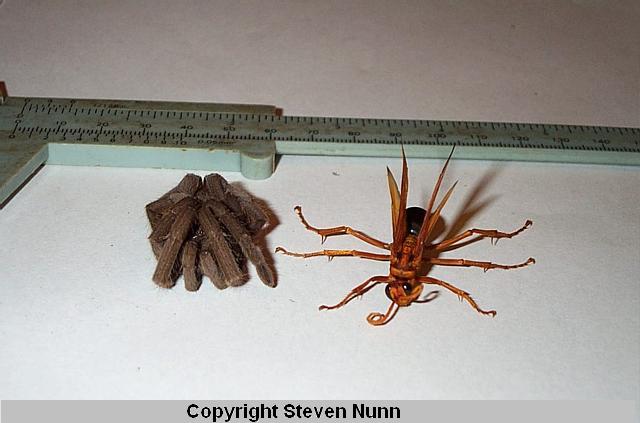 The only creatures, which hunt on tarantulas in nature are hawk-wasps from family Pompilidae, from which well studied the species of genuses Pepsis and Hemipepsis (the biggest can reach 10 cm in legth), which after paralysing a spider, put in his abdomen an egg. Hatched from egg hawk-wasps larvae all its further development eats such "tinned food"(Dr. F. Punzo, 1999).
The only creatures, which hunt on tarantulas in nature are hawk-wasps from family Pompilidae, from which well studied the species of genuses Pepsis and Hemipepsis (the biggest can reach 10 cm in legth), which after paralysing a spider, put in his abdomen an egg. Hatched from egg hawk-wasps larvae all its further development eats such "tinned food"(Dr. F. Punzo, 1999).
See interesting movie about it.
It is possible to count as other enemies a large predatory centipedes, constantly moving on surfaces of ground in searches of food.
Such species as Scolopendra gigantea, some specimens of which reaches 40 сm lengthwise, able to cope with a tarantula of significant size.
It is also known some facts of parasitising on tarantulas by small "flies" of genus Megaselia of family Phoridae, which maggots, as well as larvae of hawk-wasp, developing inside tarantula, but, unlike lasts, insertion of the egg by imago is produced not in paralyzed, but on covers of alive spider. Maggot eats itself the road in the body of spider through soft cuticle of joints, finally, causing taramtula death. Imago itself eat remainders of food, tarantula droppings etc.
Lifecicle from egg to imago forms at the average 20-21 days.
These "flies" can be confused with other flies – well known to many fruit-flies.
However fruit-flies meet in terrariums with tarantulas extremely seldom and differ from others by red colouration of eyes.
Want also to note that, aside from earlier mentioned species of frogs, also the representatives of small group of diptera insects live in nature in tarantula burrows.
They laying eggs directly on the spider or in soil of its burrow. Herewith maggots concentrate in the field of oral hole of tarantula or in substratum and eat organic remainders.
It is interesting that three southamerican tarantula species - Theraphosa blondi, Megaphobema robustum and Pamphobeteus vespertinus - has their own specific species of that diptera insects.
In captivity, usually, meets representatives of two groups of diptera – Phoridae flies (rarely seen) and also so-called «potted flies».
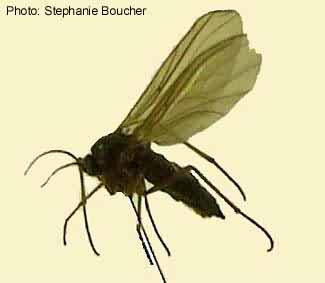 In absolute majority this «potted flies» are species of midges of families Fungivoridae and Sciaridae, and wound in terrariums with bad ventilations because of long-time of overmoisting of substratum and its following rotting, and decay in humid conditions of remainders of food and droppings of spider, with the result that is formed fungous microculture, which eats by its maggots.
In absolute majority this «potted flies» are species of midges of families Fungivoridae and Sciaridae, and wound in terrariums with bad ventilations because of long-time of overmoisting of substratum and its following rotting, and decay in humid conditions of remainders of food and droppings of spider, with the result that is formed fungous microculture, which eats by its maggots.
Amateurs and collectors in hothouse flowers culture regularly faces with these "flies". Also sometimes they meet in potted culture of plants, whence they have got its name. They are smaller, more fine than insects of family Phoridae, with dark wings and are actively fly.
Phoridae flies look more spicate and hunchbacked in contrast with "potted", much seldom fly - only being disturbed, mainly moving on substratum by typical jerks.
To dispose of them You must replace substratum and disinfect a terrarium. Also You can dry off a substratum with obligatory granting herewith a tarantula water bowl for drinks.
In general, all «potted flies» absolutely safe for spiders, but can cause their enxiety. Herewith specified problems, as a rule, do not appear at presence of good ventilation of terrarium.
Finally want to note that once in a while in tarantula terrariums meets broughted, as a rule, with substratum a representatives of small invertebrates - colembolas and pillbugs, which also do not cause a tarantula any harm.
So what is necessary to know about tarantulas, what difficulties appear under their keeping and what conditions is necessary to create for they not only well felt itself at Your home but also bred?